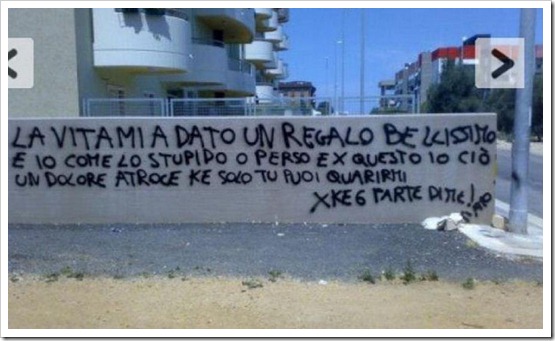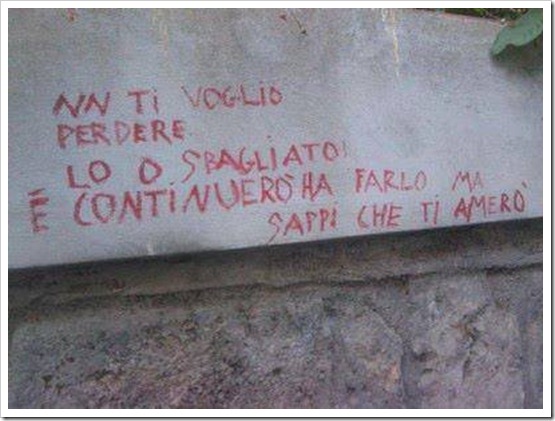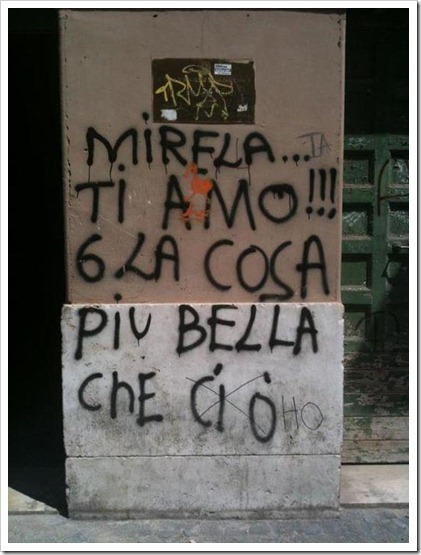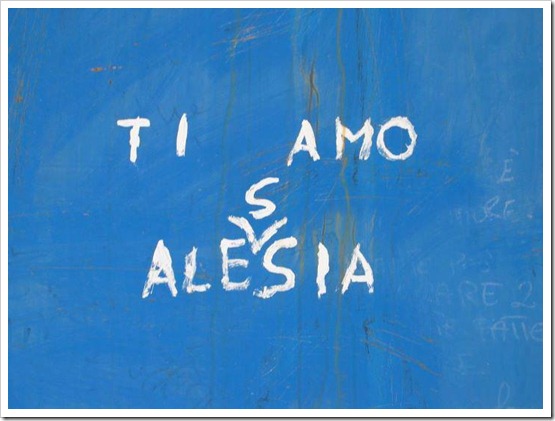How Not to Say I Love You in Italian Posted by Serena on Jan 29, 2014 in Grammar, Italian Language
Italians are very romantic, and town walls all over Italy are covered in graffiti with big passionate declarations of love. Ma amore non fa sempre rima con cuore (but love does not always rhyme with heart), as we say in Italian, so despite the good intentions these romantic graffiti are often full of grammatical mistakes which can make them very comical at times:
 |
| such as this very simple one: PEDONAMI |
The writer of the message above forgot an ‘r’, so instead of ‘perdonami’ (forgive me), he/she wrote ‘pedonami’ which can be interpreted as ‘run me over’ (pedone is a pedestrian or a pawn in chess. The verb ‘pedonare’ doesn’t actually exist but to me this image conveys the idea of a pedestrian run over by a car).
The next photo is an example of graffiti written using text messaging shorthand, peppered with numerous grammatical errors and spelling mistakes (to find out more about text messaging in Italian click here):
 |
| LA VITA MI A DATO UN REGALO BELLISSIMO E IO COME LO STUPIDO O PERSO E X QUESTO IO CIÒ UN DOLORE ATROCE KE SOLO TU PUOI QUARIRMI XKE 6 PARTE DI ME! |
Translated into Italian the graffiti should read: “La vita mi ha dato un regalo bellissimo e io come uno stupido l’ho perso e per questo io c’ho un dolore atroce che solo tu puoi guarirmi, perché sei parte di me!” (Life gave me a wonderful present and I, like an idiot, lost it, that’s why I have a terrible pain that only you can cure, because you are part of me!)
A very common mistake in a lot of graffiti is missing out the letter ‘h’, which is not pronounced in Italian but is written, e.g. ‘o’ instead of ‘ho’ (I have), ‘ai’ instead of ‘hai’ (you have), and ‘a’ instead of ‘ha’ (he/she/it has). But it’s interesting and sad at the same time to notice that these writers still have a vague memory of the existence of a silent ‘h’ somewhere in their spelling, so this letter sometimes appears in the most unexpected places. The example below is a wonderful collection of misplaced h’s and accents:
 |
| NN TI VOGLIO PERDERE LO O SBAGLIATO È CONTINUERÒ HA FARLO MA SAPPI CHE TI AMERÒ |
Italian translation: “Non ti voglio perdere. Lo (io?) ho sbagliato e continuerò a farlo, ma sappi che ti amerò (I don’t want to lose you. I was wrong and I will continue to be, but you must know that I will love you).
Some people cannot resist the temptation of correcting the mistakes of others:
 |
| MIRELA … TI AMO!!! 6 LA COSA PIU BELLA CHE CI Ò |
Italian: “Mirella … Ti amo!!! Sei la cosa più bella che ho” (“Mirella … I love you!!! You are the most beautiful thing I have”)
… or add amusing comments:
 |
| CON TE ACCANTO POSSO RINUNCIARE HA TUTTO … ANCHE ALL’ITALIANO … |
Original message in red: “With you by my side I can give up everything …” added later in black: “even the Italian language …” (referring to the ‘h’ in front of the preposition ‘a’, in Italian we say rinunciare a tutto, to give up everything)
But this has to be my favourite:
 |
| I LOVE YOU ALESIA … whoops, I mean ALESSIA |
You can find more grammatically incorrect love graffiti on this site: amori grammaticalmente scorretti, and if you feel like doing a bit of graffiti yourself you’d better read our blog How to Say ‘I Love You’ in Italian.
Now, who’s going to admit to having written romantic graffiti, come on, own up … leave a comment.

Build vocabulary, practice pronunciation, and more with Transparent Language Online. Available anytime, anywhere, on any device.




Comments:
Elaine:
A very interesting and amusing piece! But unfortunately you are guilty of making a very common English error ;). Many people confuse “loose” (allentato o sciolto) with “lose” (perdere). In the third example above, you should say “I don’t want to LOSE you”.
I’m not much more than a beginner in Italian but I was happy that I could understand most of these messages – and spot a lot of the errors!
I love your blogs and I print a lot of them out and put them in my Italian file to help my learning!
Serena:
@Elaine Salve Elaine, thank you for spotting “my” mistake. I edited it immediately. Mi fa piacere che ti piaccia il nostro blog e che questo articolo ti abbia divertito.
Saluti da Serena
Linda:
Thank you so much for this blog. I teach a beginner Italian class and I often print your blog out and we read it together. Great teaching tool! But I am a student of Italian also and struggle to improve. I have one question here. Sappi – I thought the subjunctive of sapere was sappia and the imperative was sappi. That would mean that the writer is saying ‘you must know’. Am I wrong about this? Thanks for your help!
Marco:
Questo blog è sempre interessante ed anche utile. Grazie mille.
Geoff:
@Marco Salve Marco, grazie per i complimenti.
Saluti da Geoff
Robb:
The verb “pedonare” exists and means “to follow on foot”. In that case, it can be translated as “Stalk me!”. Hilarious nonetheless.
Serena:
@Robb Salve Robb, where did you find the verb ‘pedonare’? I can’t find it in my Italian dictionaries, and when I type ‘pedonare’ in Google Italia it gives me either ‘perdonare’ (to forgive) or ‘pedonale’ (pedestrian). As for ‘to follow on foot’, the Italian verb is ‘pedinare’.
Saluti da Serena